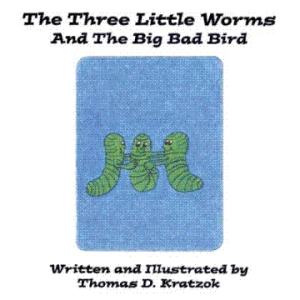The Three Little Worms and the Big Bad Bird
These three worm siblings convey a friendlier message than their porky predecessors—one of cooperation and innovation.
Even classic stories benefit from a tweak now and then—and Thomas Kratzok has done just that, changing the three little pigs to worms and the wolf to a bird in his remaking of the Three Little Pigs, The Three Little Worms and the Big Bad Bird.
Kratzok’s three worms make homes in an apple, a corn cob, and a log, as the Big Bad Bird tries its best to peck them out. True to the Three Little Pigs plot, the first two worms end up inside the third worm’s log, the only home that proves birdproof. Kratzok adds a fun, inventive ending, when the bird decides to wait for the worms to leave the log in search of food. Faced with the choice of starvation or being eaten by the bird, the third and wisest worm comes up with a plan—after finding an old snakeskin, the three worms work together to pose as a snake and scare the bird away. In a less accusatory moral than the original Three Little Pigs’ lesson about the dangers of laziness and cutting corners, the worms learn that “in order to survive in this world; you must cooperate and stick together.”
The Three Little Worms and the Big Bad Bird suffers from poor editing, such as a misused semicolon in the sentence above, and incorrectly used words and missing punctuation, as seen on the book’s first page: “But the Three Little Worms could not agree on the kind of home they should live in. So they split up and went there own way”
Kratzok is an experienced author, having written and illustrated many other picture books for children, including Why the Chicken Crossed the Road, Why Should I Listen?, and Happy the Hippo. Kratzok’s illustrations are a raw, unpolished colored pencil, and while this style isn’t necessarily well suited to reproduction—there are bare spots in the backgrounds and some inconsistency in the shapes and sizes of the subjects of the drawings—they do have a certain quaint charm.
The story itself should appeal to children immensely, since they’ll be able to pick out and be entertained by the differences from the classic pigs’ story. For example, instead of “Not by the hair of my chinny chin chin,” the characters utter the worm-friendly, “Not by the slime of my skinny, skin, skin.”
The Three Little Worms and the Big Bad Bird could be called an imperfect success—a cute, entertaining tale, that could have been more carefully put together, but offers a nice twist on a classic and a great message.
Reviewed by
Peter Dabbene
Disclosure: This article is not an endorsement, but a review. The publisher of this book provided free copies of the book and paid a small fee to have their book reviewed by a professional reviewer. Foreword Reviews and Clarion Reviews make no guarantee that the publisher will receive a positive review. Foreword Magazine, Inc. is disclosing this in accordance with the Federal Trade Commission’s 16 CFR, Part 255.

